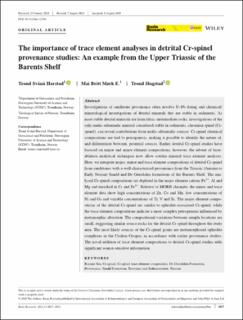| dc.description.abstract | Investigations of sandstone provenance often involve U–Pb dating and chemical/mineralogical investigations of detrital minerals that are stable in sediments. As most stable detrital minerals are from felsic–intermediate rocks, investigations of the only mafic–ultramafic mineral considered stable in sediments, chromian spinel (Cr-spinel), can reveal contributions from mafic–ultramafic sources. Cr-spinel chemical compositions are tied to petrogenesis, making it possible to identify the nature of, and differentiate between, potential sources. Earlier detrital Cr-spinel studies have focused on major and minor element compositions, however, the advent of laser-ablation analytical techniques now allow routine mineral trace element analyses. Here, we integrate major, minor and trace element compositions of detrital Cr-spinel from sandstones with a well-characterised provenance from the Triassic (Anisian to Early Norian) Snadd and De Geerdalen formations of the Barents Shelf. The analysed Cr-spinel compositions are depleted in the major element cations Fe3+, Al and Mg and enriched in Cr and Fe2+. Relative to MORB chromite, the minor and trace element data show high concentrations of Zn, Co and Mn, low concentrations of Ni and Ga and variable concentrations of Ti, V and Sc. The major element compositions of the detrital Cr-spinel are similar to ophiolite-associated Cr-spinel, while the trace element compositions indicate a more complex petrogenesis influenced by metamorphic alteration. The compositional variations between sample locations are small, suggesting similar source rocks for the detrital Cr-spinel throughout the study area. The most likely sources of the Cr-spinel grains are metamorphosed ophiolite complexes in the Uralian Orogen, in accordance with earlier provenance studies. The novel addition of trace element compositions to detrital Cr-spinel studies adds significant source-sensitive information. | en_US |

